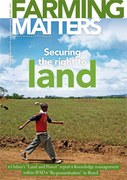Eric Holt-Gimenez argues that “Wall Street has been occupying our food system”, and this has had disastrous results. In 2008 and again in 2010, prices for staple crops like rice, wheat, and corn doubled and tripled, extending the grip of poverty and deprivation to hundreds of millions of people.
Farming Matters | 27.4 | December 2011
A day doesn’t go by that the present food crisis – in which nearly a billion people are going hungry – is used as proof of the food scarcity plaguing the planet. There is scarcity – but not of food. The world produces enough food. People are going hungry today because they can’t afford food, especially when prices spike. The recent extreme price volatility and price spikes cannot be explained by simple supply and demand models. In fact, there has hardly been any change in world food demand over the last three years. The falling land productivity of industrial agriculture, the spread of agrofuels diverting arable land to fuel crops, climate change and an inadequate investment in agroecology are all adversely affecting food supply. But despite their devastating impacts, these supply-side factors don’t explain the extreme volatility and price spikes in global food markets seen in recent years.
Food price surges are the result of a new phenomenon: massive hoarding of food commodity derivatives. These are specialised financial products invented by powerful financial institutions. As a result, prices skyrocket because these investors have created a financially-induced demand, thereby imposing immense artificial scarcity on the global food market. In 2008 and again in 2010, prices for staple crops like rice, wheat, and corn doubled and tripled, and extended the grip of poverty and deprivation to hundreds of millions of people. And what’s more, institutional investors knew their speculation was driving food prices higher.
The “financialisation” of our food began with the creation of tradable commodity indexes, which turn some of the basic necessities of life into speculative assets. The trading of agricultural commodities, which in itself serves an important function for corporations with a real stake in agricultural commodities, is taken advantage of by financial speculators. Financial speculators are merely concerned with financial profit – not the destination of the food commodity or the functionality of the global food system. On top of this, new regulations allow institutional investors to trade commodity futures contracts without position limits, disclosure requirements or regulatory oversight. With the crash of the housing bubble, followed by the economic recession, institutional investors flocked to the unregulated commodity index funds. As a result, financial capital flooded the market, taking massive positions in food and concentrating them in just a few, corporate hands – without having to report any of it!
By opening up food commodities to financial speculation, global food commodity markets have seen the most price volatility and biggest price surges ever. The Occupy Wall Street protestors are not off the mark. Wall Street has been occupying our food system for far too long – with disastrous results.
Text: Eric Holt Gimenez
A longer version of this column appeared first in The Huffington Post.

